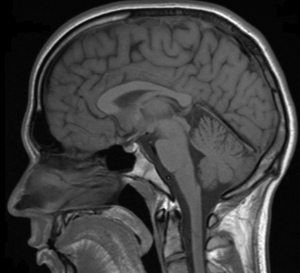
Influencing decision-making

Researchers have been able to tap into the decision-making processes in the brain to play with our sense of value.
A number of studies have shown that the two halves of the brain deal with magnitudes – such as time, space, and numbers – in different ways, with the left side of the brain dealing with larger magnitudes and the right side processing smaller magnitudes.
Now, new research suggests that choices based on values, such as financial decisions, are dependent upon how these two halves of the brain interact. What’s more, the subsequent decision-making can be altered by interfering with how the brain processes magnitudes, altering the notion of what things are worth.
This opens up a way to examine a person neuroscientifically, to see how they make their decisions
– Dr Qadeer Arshad
Study author
In two recently published papers, researchers from Imperial’s Division of Brain Sciences have shown they can influence economic decision-making, altering the way people split a cash pot.
Dr Qadeer Arshad, an honorary lecturer at Imperial and clinical scientist at Charing Cross Hospital, who led the research, said it showed that they could “influence decision-making by interfering with how the brain works”.
Previous work by the group revealed a biological basis for number biases in the brain. Typically, one side of the brain is slightly more dominant, but the way these two halves of the brain interact can affect decision making. Our brains are thought to process numbers using a number of different regions in the left and right halves of the brain, collectively called the fronto-parietal network.
Which side of the brain is more dominant can be revealed through a slight bias towards larger or smaller numbers. Those with a more dominant left hemisphere of the brain are likely to have a bias for larger numbers – which means given a choice they are more likely to pick a larger number – while those with a more dominant right hemisphere are biased, or more likely to pick, lower numbers.
Biological bias
During the first study, participants were asked to pick the midpoint between two random numbers in a limited time period, not giving them enough time to actually calculate – for example, ‘choose the midpoint between 34 and 87’ – to spot any bias for larger or smaller magnitudes.
Their performance was then assessed during a standard decision-making test called the ‘dictator game’, which is often used by economists to model social behaviours. In this setup, people are offered a sum of money (£5) and told they have to share it with a stranger.
“In the study, we found that those people who were biased towards lower numbers were less generous – in that they made less favourable economic decisions towards the stranger, during the task,” explained Dr Arhsad. “Those biased towards larger numbers tended to give more money to the stranger.”

Choices based on values are dependent upon how the two halves of the brain interact
In further trials, they were able to skew the direction of decision-making. They found that dripping water into a participant’s ear and simultaneously viewing a visual stimulus caused the hemispheres to compete, leading to one side of the brain being inhibited – depending on which ear it was applied to.
Using this approach, they could subliminally bias individuals towards either smaller or larger numbers, actively driving choices during decision-making.
Pushing individuals toward small numbers led to a more selfish split, with the player giving less of the pot away. Whereas when the same individuals were pushed to larger numbers resulted in a better outcome for the stranger, with players opting to split more of the £5 pot with them.
Tapping into the process
Dr Arshad said: “The surprising thing is that we could override what they were actually told. At all times they had the same £5, but their brains seemed to ignore that completely and went with how they processed that value.
"In the same person, the £5 was made to appear as £6 or £4, and we were able to alter their corresponding decisions, but at all times, they thought they were making the same economic decisions.”
If we could alter how the brain constructs perceptions, we might be able to alter people’s interpretation and behaviour
– Dr Qadeer Arshad
Study author
These findings were backed by a second set of trials involving patients with Parkinson’s disease. Early on in the disease, there can be a mismatch between the hemispheres as one half of the brain is affected more than the other. Based on the trials with healthy volunteers, this mismatch would be expected to shift the number bias, depending on whether the left or ride side was more affected by the disease.
Running the same tests, they found that those with more damage to the right-hemisphere (where the left side of the brain became more dominant) were more biased towards larger numbers and made more generous decisions during the decision making task The opposite was seen in those patients with more damage to the left-hemisphere.
According to the researchers, the findings could prove useful in studying how people make decisions. It could also help to better understand conditions in which the communication between the hemispheres is disrupted, affecting how signals from the body or even outside are perceived.
Dr Arshad explained: “This opens up a way to examine a person neuroscientifically, to see how they make their decisions."
He added: “It could open up avenues towards treating certain conditions, such as chronic dizziness and pain.
"These are essentially perceptual disorders, based on how you perceive stimuli. In theory, if we could alter how the brain constructs perceptions, we might be able to alter people’s interpretation and behaviour.”
-
‘Influence of biases in numerical magnitude allocation on human pro-social decision making’ by Arshad, Q. et al. is published in the Journal of Neurophysiology.
‘Biased numerical cognition impairs economic decision-making in Parkinson's disease’ by Arshad, Q. et al. is published in the Annals of Clinical and Translational Neurology.
Images: Main (Shutterstock), Brain (Helmut Januschka)
Article text (excluding photos or graphics) available under an Attribution-NonCommercial-ShareAlike Creative Commons license.
Photos and graphics subject to third party copyright used with permission or © Imperial College London.
Reporter
Ryan O'Hare
Communications Division

Contact details
Tel: +44 (0)20 7594 2410
Email: r.ohare@imperial.ac.uk
Show all stories by this author




Leave a comment
Your comment may be published, displaying your name as you provide it, unless you request otherwise. Your contact details will never be published.